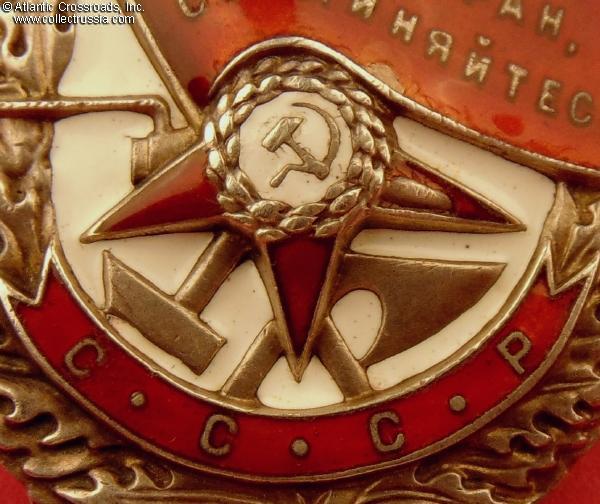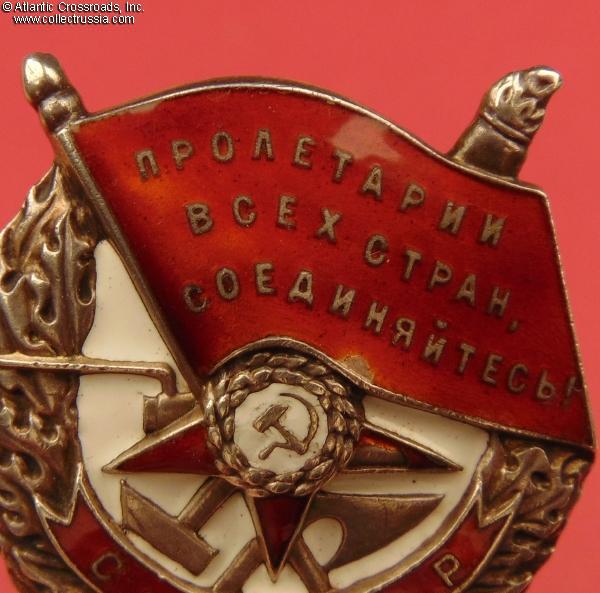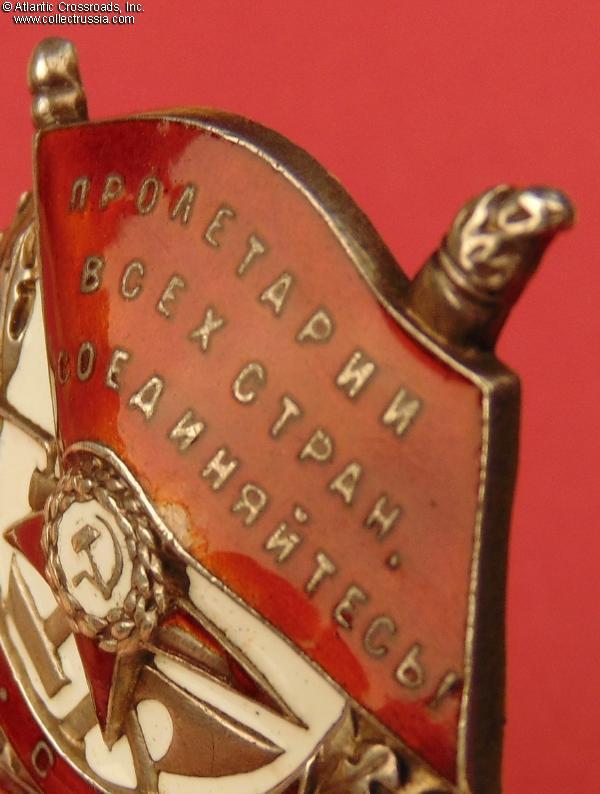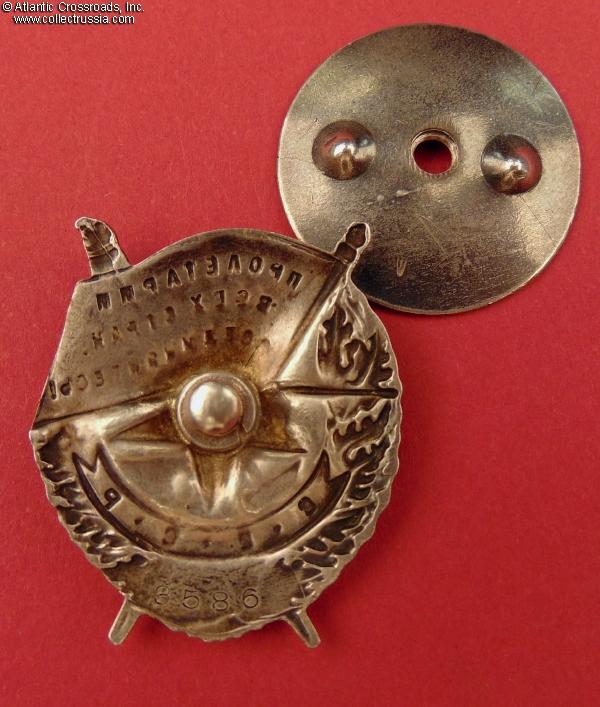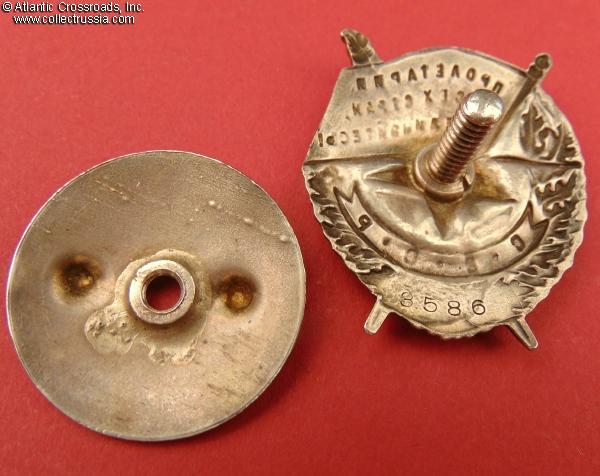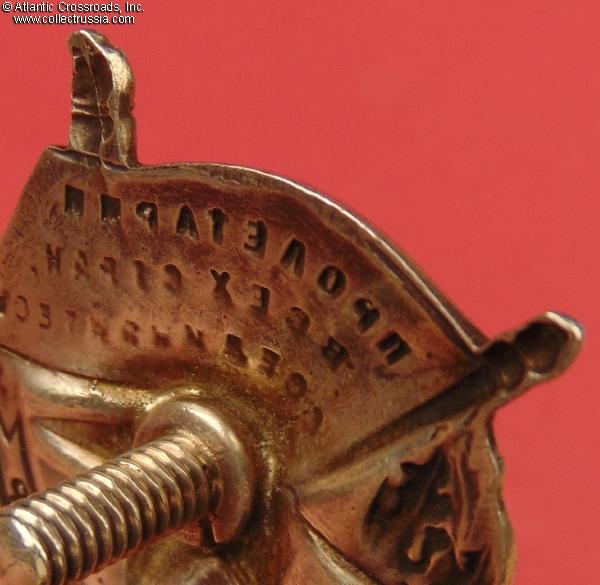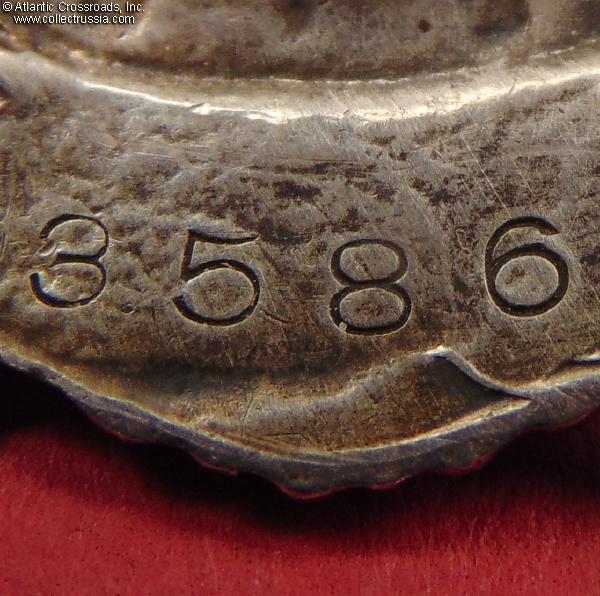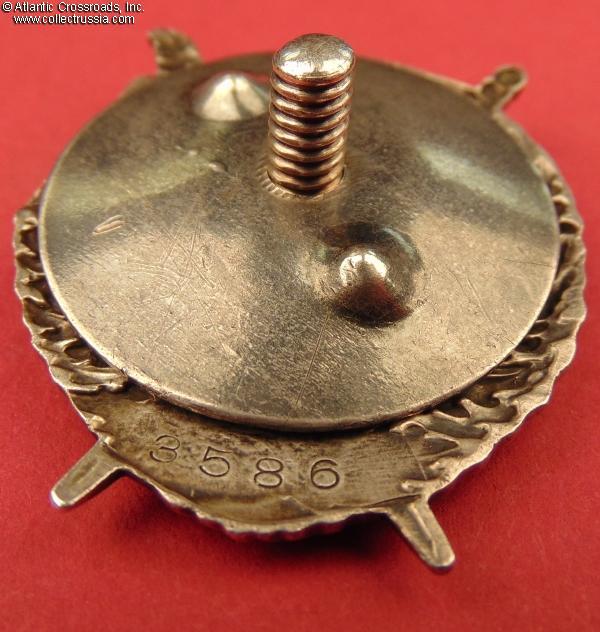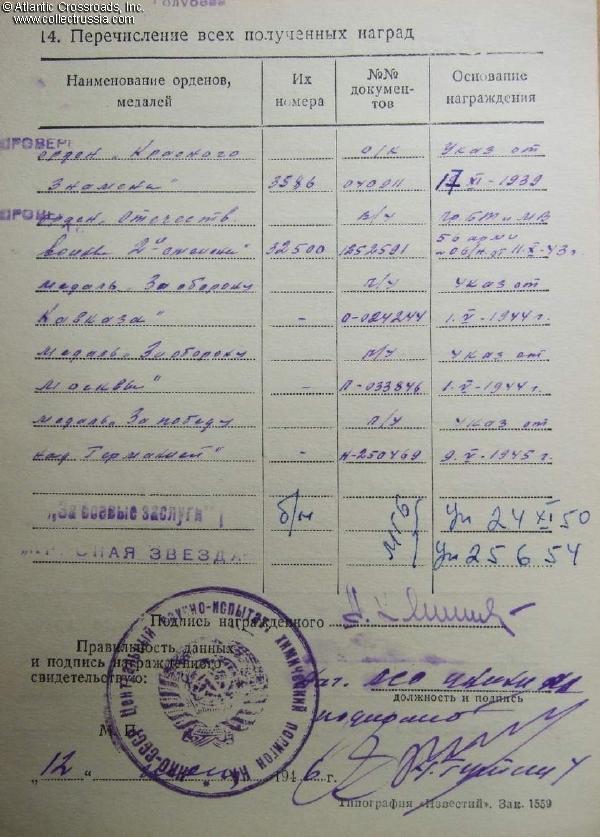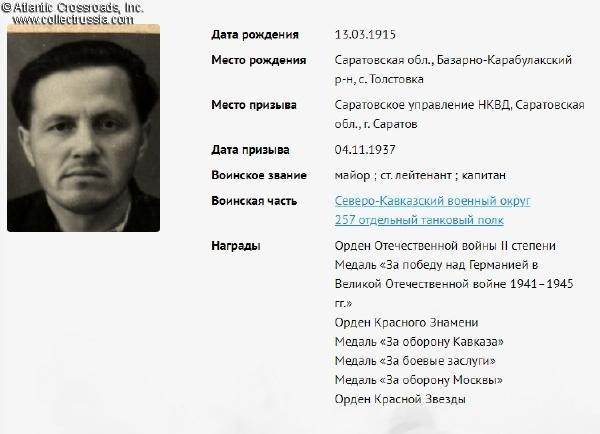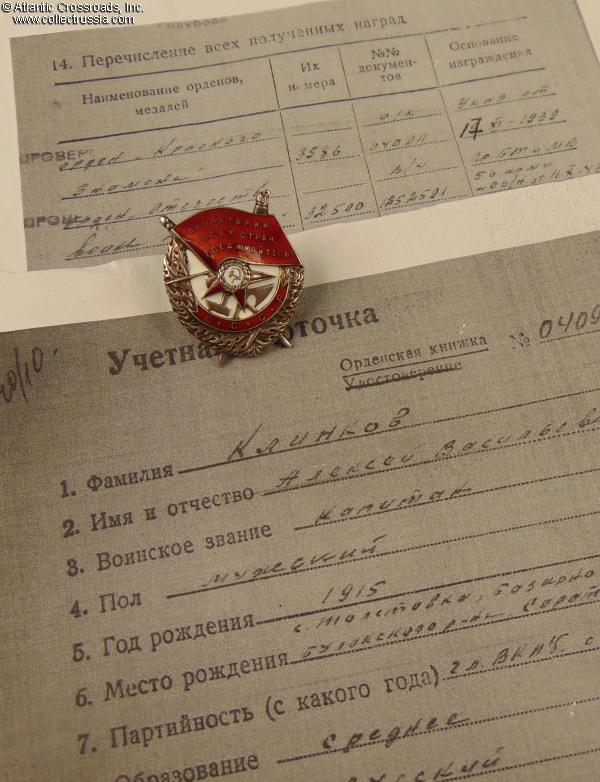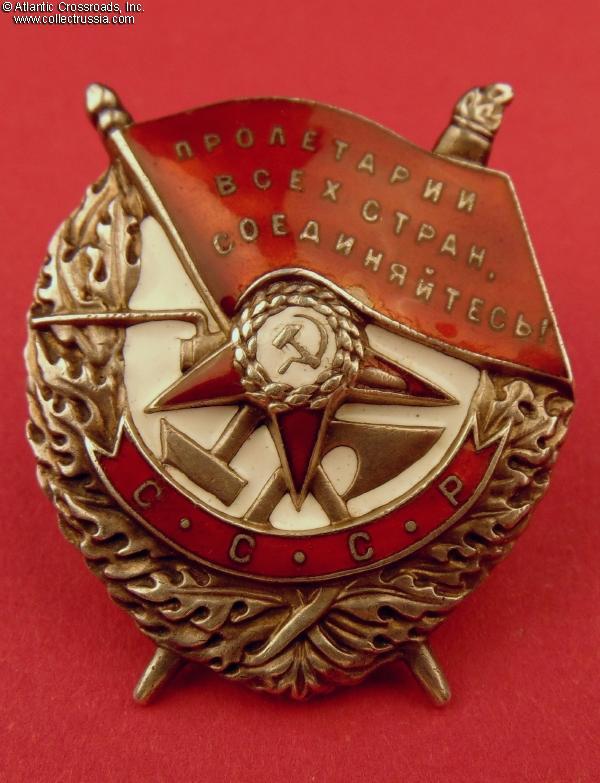
Order of the Red Banner, Type 1, Variation 2, Sub-variation 2 (Strekalov classification), #3586, awarded on 17 November 1939 to Aleksey Klinkov (Алексей Васильевич Клинков), a SMERSH Counterintelligence Officer.
Silver gilt, enamels; measures 39.9 mm in height (from the top of the flag to the bottom of the wreath), 36.0 mm in width; weighs 23.0 g not including the screw plate. The screw post is approx. 4.6 mm in diameter. This so-called "Mirror Reverse" version of the order (Type 1 Var. 2 according to the McDaniel classification) features relatively smooth lines of the counter-relief on the reverse. The area for the serial number is flat rather than "sunk-in" and is taller than on the vast majority of other "Mirror Reverse" specimens. Note the serial number, very low even for the "Mirr
Silver gilt, enamels; measures 39.9 mm in height (from the top of the flag to the bottom of the wreath), 36.0 mm in width; weighs 23.0 g not including the screw plate. The screw post is approx. 4.6 mm in diameter. This so-called "Mirror Reverse" version of the order (Type 1 Var. 2 according to the McDaniel classification) features relatively smooth lines of the counter-relief on the reverse. The area for the serial number is flat rather than "sunk-in" and is taller than on the vast majority of other "Mirror Reverse" specimens. Note the serial number, very low even for the "Mirror Reverse" Red Banner. Based on The Order of the Red Banner by Durov and Strekalov, this piece is from a small series manufactured by the Leningrad Mint in 1932.
The order is in very fine condition, which would be far above the average even for a regular WW2 "screw back" and is extraordinary for an early "Mirror Reverse" awarded prior to the Winter War. Uncharacteristically, the enamel shows magnificent luster throughout and practically none of the usual rubbing and scratches. The banner in particular is preserved far better than usual, having only a single tiny chip at the lower edge above the star and some minuscule surface flakes along the edges but no glaring damage or repairs of any sort. The center star has enamel partly missing on the left arm, while the other two arms are largely intact having only a tiny amount of flaking that is almost unnoticeable to the naked eye. The red plaque with "CCCP" has microscopic contact marks only, no wear visible without magnification. The white enamel in the center of the star has tiny flakes around the hammer & sickle emblem, also invisible to the unaided eye, while that on the outer part of the medallion is perfect.
The details of the wreath, torch and flagpole are perfectly crisp. The reverse is pristine and shows beautiful even patina. The screw post is approx. 13 mm in length measured from its base, and has not been shortened. Comes with the early version of a 32-mm silver screw plate, which is correct for a "Mirror Reverse" in its serial number range and probably original to the award.
To summarize, the condition of this piece is absolutely outstanding for an early "Mirror Reverse" Red Banner awarded prior to the Winter War against Finland and the Patriotic War.
Born in 1915 in a village of Saratov Province of Russia, Aleksey Klinkov enlisted in the NKVD in November 1937. In 1939, he joined the Communist Party and in November of the same year, was awarded with an Order of the Red Banner. Although his specific achievements or place of service at the time are unknown, the award was bestowed by the 17 November 1939 decree of the Presidium of the Supreme Soviet of the USSR. Ostensibly, the decree was in commemoration of the anniversary of the First Cavalry Army of the Russian Civil War fame. However, the vast majority of the award recipients named in it were Red Army and NKVD servicemen who had distinguished themselves in the recent August - September battles against the Japanese at Khalkhin Gol or in the so-called "Liberation" campaign against Poland in September. It is highly probable, practically certain, that Klinkov earned his Order of the Red Banner in either of these two conflicts on the offset of WW2.
Later during the war, Klinkov fought in the Battle of Moscow and, while serving as a Senior SMERSH Counterintelligence officer with the 257th Separate Tank Regiment, took part in the defense of Caucasus. On 11 October 1943, he was awarded with an Order of the Patriotic War, 2nd cl. by a general order for the Armored and Mechanized Troops, 56th Army that was at the time a part of the Coastal Group of Troops, North Caucasus Front. Following a long and extremely bloody stalemate, the army had just broken through the infamous German "Blue Line" on the Taman Peninsula. Although full text of the award commendation for the award is not available, the Russian archival website Pamyatnaroda.ru has a small excerpt of it showing that throughout the offensive Klinkov was constantly on the front lines where he conducted a "merciless struggle against cowards and panic-mongers". He also keenly "monitored the mood" of the personnel and reported it to the command of the unit. Thanks in part to his efforts, the regiment had not a single case of "betrayal of the Motherland, cowardice, or desertion" (this seems to contradict the previous statement in the commendation, making it unclear what "cowards" Klinkov mercilessly eradicated if there were none to begin with.)
After the war, Klinkov remained on active duty in the NKVD (later renamed MGB), earning a Medal for Combat Service and Order of the Red Star in 1950 and 1954, respectively. As of 1946, he had the rank of NKVD Captain serving as a SMERSH executive officer with the Red Army Chemical (Weapons) "Research and Testing" Proving Ground. Based on the information available on the Russian-language Pamyat-naroda.ru website, Klinkov retired in 1954 having the rank of Major.
Although many details of Klinkov's service remain unknown and may still be classified, an eventual opening of the Russian archives may someday shed light on specific details of his military career. His 1939 Order of the Red Banner is certainly a very interesting piece with a great research potential!
Research Materials: photocopy of the award record card; copy of the archival photo of the recipient; part of the award commendation for
the Order of the Patriotic War, 2nd cl. Additional information about the recipient including his photo is available on the Russian archival
websites Pamyat-naroda.ru and Povignatoda.ru.
$3,750.00 Add to cart



